10th April 2025
Most of the time, when we think about assessment, we think about grades, tests, and final scores. But what if assessment wasn’t just about measuring learning, but actually improving it? That’s the idea behind Assessment for Learning, or ‘AfL’ for short. In AfL, teachers use assessments to guide students and help them improve. Students are encouraged to discuss what success looks like, self-assess, and give feedback to their classmates. These activities help students better understand what they need to improve and how to get there.
A couple of years ago, I ran a teacher training course on Assessment for Learning. The teachers on the course all agreed that AfL sounded great. There was just one problem – time. The teachers said they had so much content and test preparation to get through in class, they didn’t have time for things like discussions, self-assessment, and peer feedback.
Enter AI. AI can make AfL more manageable and efficient for both teachers and students. It can help students understand what’s expected of them, lead them to reflect on their progress, and guide them through peer reviews. AI can save time for teachers by generating quizzes, simplifying lesson aims, and preparing activities. In this post, we’ll look at how AI can turn Assessment for Learning from an ambitious idea into an achievable reality. We’ll look at four aspects of assessment for learning:
- Diagnostics – checking what students already know before teaching something new.
- Learning intentions – making objectives clear and student-friendly.
- Success criteria – guiding students to understand what success looks like.
- Reflection and peer review – helping students evaluate their own work and give meaningful feedback to peers.
These four elements happen at different stages in a unit or project:
- Diagnostics happen before teaching new content.
- Learning intentions help students focus during a lesson or unit.
- Success criteria are most useful before a major task.
- Reflection and peer review come after students complete a task.
Let’s look at each stage in order.
Before the Unit: Diagnostics
Before you start teaching something new, it helps to know what your students already know. That’s where diagnostics come in. One of my favorite quotes about learning comes from David Ausubel (1968):
One of my favourite quotes about learning comes from David Ausubel (1968):
“The single most important factor influencing learning is what the learner already knows. Ascertain this and teach him accordingly.”
This is what diagnostics are all about—finding out what students already know before teaching something new. If you’ve ever done any of the following, you’ve used diagnostics:
- Asked students to flip through the next unit in their coursebook, note what looks familiar, and highlight what they need to learn.
- Started a lesson or unit with a quiz to check how confident students feel about the topic.
- At the beginning of a unit, asked students a question from the end of a unit to see how much they can already do.
- Began a lesson with a communicative task and listened for what students struggle to communicate.
All of these strategies avoid teaching things that your students already know, but they take time. Let’s look at how AI can help.
Objectives into Questions
AI can rephrase lesson or unit objectives as questions for students to reflect on.
Prompt: I will show you the unit/lesson objectives for my English language learners. I want you to rewrite these in {CEFR} level English, phrasing them as questions for students to answer to gauge their current level of ability or confidence. ### Unit/lesson objectives: {enter your aims here}
Students can answer these questions at the beginning of a unit. They can revisit the questions at the end of the unit to see how much they’ve improved. By listening to the answers, you can learn more about what they already know.
Make Diagnostic Quizzes
Instead of creating tests about what students will learn from scratch, AI can generate a simple quiz to check what students already know.
Prompt: Look at my lesson plan. I want you to write a quiz to check what students already know about what I will teach in the class. Write this as a {type of quiz, e.g., multiple choice}. Please use {CEFR} level English for the quiz. I will use the answers to decide what to spend more time on in class. ### My lesson plan: {enter lesson plan here}
Since this is a low-stakes quiz (it won’t be graded), students can mark each other’s answers. When they share the results, you’ll get an overview of what they already know. You can spend less time on familiar content and more time on the areas where students need help.
These activities might take five or ten minutes at the start of a class. But they could save more time later when you skip unnecessary practice or explanations.
At the Start of the Lesson: Learning Intentions
Once you’ve planned what to teach, the next step is to help students focus on the right things. This happens at the start of a lesson or unit. That’s where learning intentions come in.
“Learning intentions” is a fancy way of saying “Tell your students what they’re going to learn”. Telling students the aim at the start of class helps them know what to focus on during the lesson. Learning intentions are like a spotlight in the theatre, guiding students’ attention to the key parts of the lesson, just as the lighting director shows you where to look on stage.
If you’ve ever done any of the following at the start of a unit or lesson, you’ve used learning intentions:
- Written your aims on the board so students can look at them during the class.
- Paused before or after an activity and asked, “How does this help us achieve our goal?”
- Told students to reflect at the end of the class by answering questions like, “What did you learn today?” Or “How confident do you feel about…?”
Explaining Lesson Aims Clearly
Learning objectives in textbooks and lesson plans are usually written for teachers, making them difficult for students to understand. AI can simplify these or provide different ways of phrasing them to make them easier to understand.
Prompt: I need to phrase a learning intention for a lesson on {topic} for students at {CEFR level}. Suggest three versions: one in the simplest English possible, one that children should be able to understand, and one in the students’ first language, {the students’ L1}.
You can then choose the learning intention that you think would be easiest for your students to understand. Even written in simple language, your aims might be too abstract, especially if you teach younger learners. To help make your aims more tangible, ask AI to give some concrete examples of what success looks like.
Prompt: I want to help students understand the learning intention "{learning intention or lesson aim}". Give three concrete examples of what achieving this might look like in a student’s work? Please use {CEFR} level English.
Before a Task: Success Criteria
Learning intentions tell students what they’re aiming for. Success criteria show them what doing a good job looks like. These come before a major task like writing an essay or giving a presentation.
Some students do badly on tests and assignments not because they’re bad at English, but because they don’t know what the teacher expects from them. Success criteria try to solve this problem by showing students what success looks like. For students, receiving success criteria is a bit like getting a dress code for a party. They make sure you don’t turn up in a tuxedo when it’s a beach party, or worse, in flip-flops when it’s black-tie.
Success criteria are best created together with students. This usually involves four steps:
- Students brainstorm how to be successful at the task (like giving a presentation, or writing a story or essay).
- The teacher adds important points students missed and removes unimportant points.
- Students organise the ideas into categories with help from the teacher.
- The class creates a poster of the success criteria to use for self and peer assessment.
Imagine your students are preparing a presentation. They might brainstorm success criteria like clear pronunciation, eye contact, starting with a hook, and ending with a call to action. You might add points the students didn’t think of, like using meaningful gestures or giving examples. The students would then group these criteria into categories (like body language, organization, and language). Finally, they’d create a poster to refer to while preparing or practicing. Because they’ve been part of the process, students remember the expectations and feel more in control of their learning.
For teachers, guiding students through this process can feel time-consuming, especially with large classes or mixed-ability groups. AI can make it easier by providing structured support at each stage.
Generating Brainstorming Questions
Many students find it difficult to think of success criteria by themselves. AI can generate guiding questions to help them reflect on what makes a strong final product.
Prompt: My students need to brainstorm ideas for learning goals. The task they are working on is {description of task}. Please write {number} questions in {CEFR} level English for them to answer to guide them through this brainstorming process.
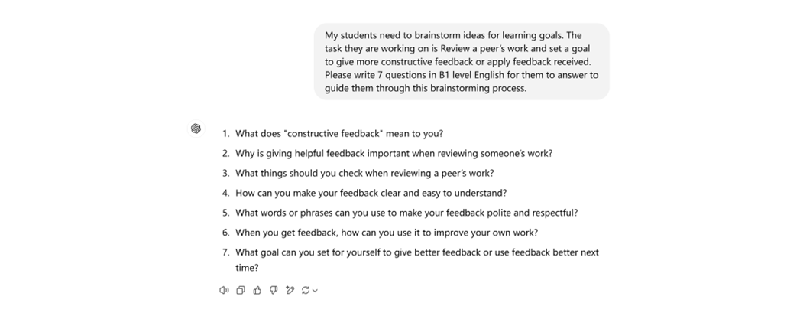
You could write these questions on the board as students brainstorm, give the questions to students to answer before they move onto brainstorming. Or, you could ask some of these questions as you monitor.
Creating Criteria
Before you ask students to think of their own criteria for a task, you’ll need to think of some yourself. This could be time consuming, and you might worry that you’ll miss some important points. AI can help you make a list of key points students should include in their work. You can use this list to add to the ideas that students brainstorm by themselves.
Prompt: My students need to brainstorm ideas for learning goals. The task they are working on is {description of task}. Please write {number} points in {CEFR} level English that would be important in completing this task. Write these as a checklist. Give examples where appropriate.
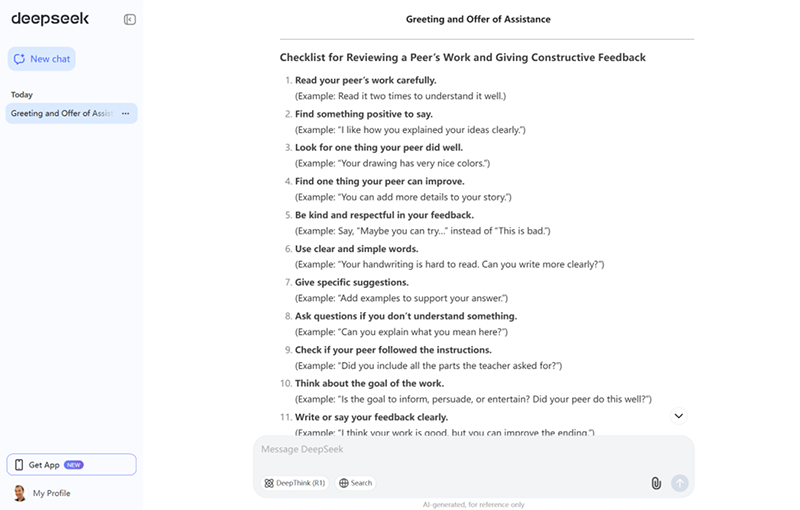
Categorising Criteria
Once students have brainstormed, they need to group their ideas into categories. AI can suggest different ways of doing this. You could use these as a starting point for students, by showing them one category and what’s in it, then ask them to do the rest. Alternatively, you could show students an AI grouping as an alternative to their own.
Prompt: I will share ideas brainstormed by students about {description of task}. Group these ideas into 3-5 distinct categories, using {CEFR} level English. Ensure each grouping reflects genuinely different ways of organizing the ideas, not just reworded categories. Provide two alternative ways of grouping the ideas. Students' ideas: {ideas from your students}
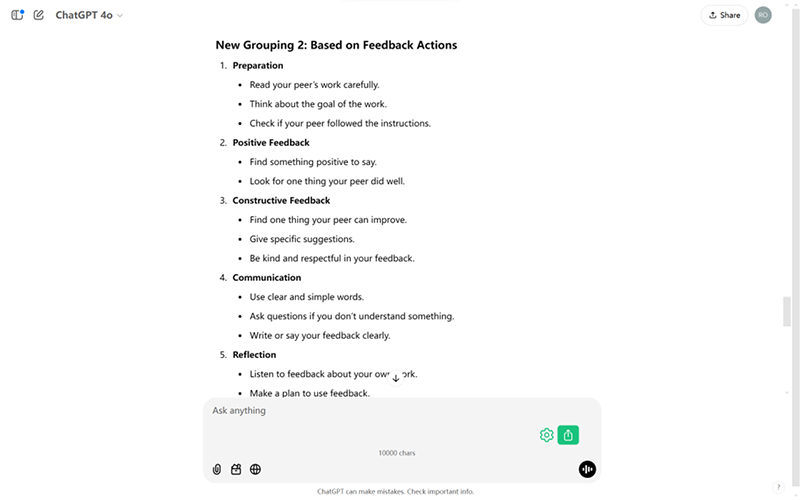
Clarifying with Examples
Once students have defined their success criteria, they may still struggle to use them to analyse their own work. AI can give examples of what each criterion looks like in practice.
Prompt: I will show you some success criteria for the task of {description of task}. Write at least one example of how I can do each of these. Please use {CEFR} level English. Success criteria: {success criteria and categories}
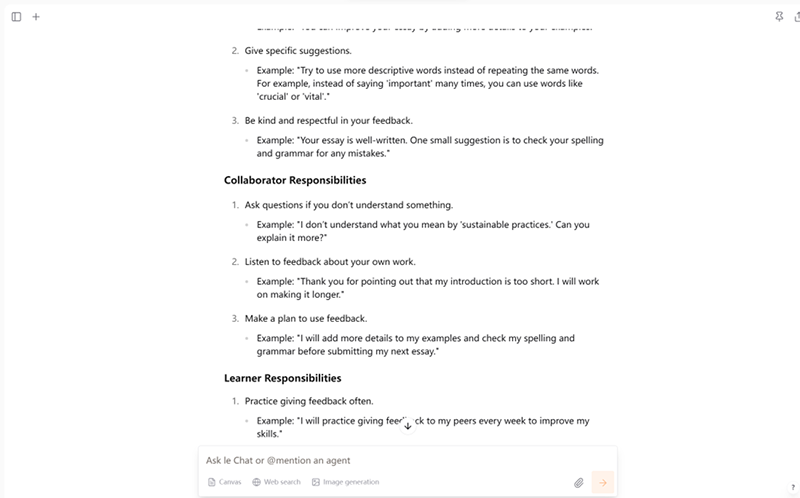
After a Task: Reflection and Peer Review
Once students complete a task, they need time to think about how they did and how to improve. That’s where reflection and peer review come in.
Reflection helps students learn and improve. At the simple end of the spectrum, reflection might just involve checking “Did I use gestures?” and “Was my pronunciation clear?”. At a deeper level, it involves thinking critically about their work and how to improve it. AI can support self-reflection by turning success criteria into a checklist. Instead of relying on memory, students can use a clear set of points to review their work. This should let them catch any missing elements before handing in their work.
Prompt: Please take the following success criteria and change these into a checklist. My students will use this to check that they have completed their work before handing it in. Success criteria: {success criteria}.
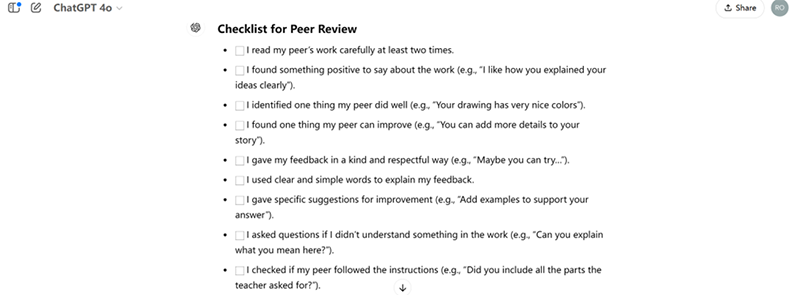
AI can also take reflection a step further by acting as a coach. It can guide students to think about how well they’ve met the success criteria. This is especially useful for students working alone, without access to immediate feedback from a teacher or peer. Higher level students might want to do this in English, while lower-level students can get coached in their first language.
Prompt: I want you to coach me to help me improve my work. Ask me questions one by one, to help me reflect on what I did well and what I could improve. Use {simple English/my first language}. Do not tell me what you think. Instead, guide me by asking questions like “How do you feel about the structure of what you wrote? Were there any sections which you were less happy with?” Use the following success criteria as a guide: {success criteria}. ### My assignment {paste the task itself here}
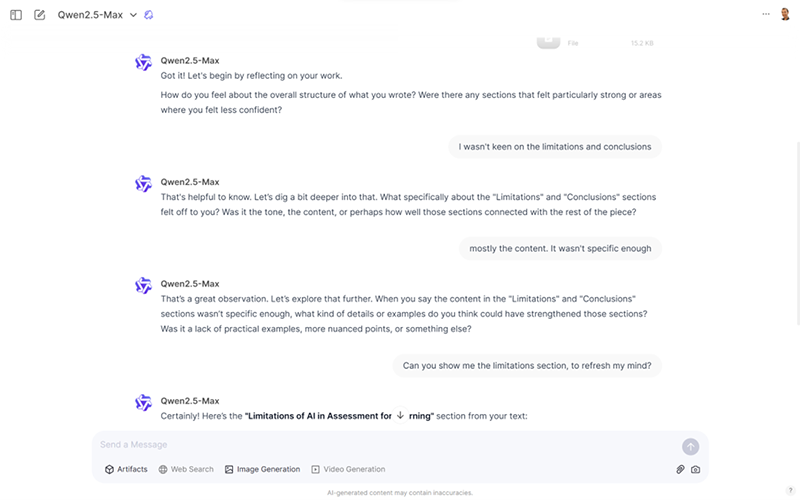
These AI generated questions encourage students to pause and think about their work. This helps students identify their strengths and areas for improvement in a structured way. This kind of self-reflection builds independence and helps students take more ownership of their learning.
Peer review
When students review a peer’s work, they develop a better understanding of what makes writing clear, logical, and well-structured. This helps students think more clearly about their own work. The challenge is that many students aren’t sure what to look for or how to phrase their feedback. Without guidance, peer review can end up negative, unclear, or vague. AI can help by coaching students through the peer review process, rather than doing the work for them. AI can guide students by asking questions, prompting reflection, and helping them organise their thoughts.
Prompt: I am reviewing my peer’s work. I want you to coach me through this process. Ask me questions one by one, to help me reflect on what I did well and what I could improve. Do not tell me what you think. Instead, guide me by asking questions like “Which parts of your peer’s work did you like the most? Why?” Ask me questions to help me identify strengths and areas for improvement based on the success criteria. Use {simple English/my first language}. ### Success criteria: {Insert success criteria}. ### Peer’s work: {Insert peer’s work} ### Ask me one question at a time, and wait for my response before moving on to the next question. Do not overwhelm me by asking multiple questions at the same time. At the end, summarise my ideas into comments that I can share with my classmate.
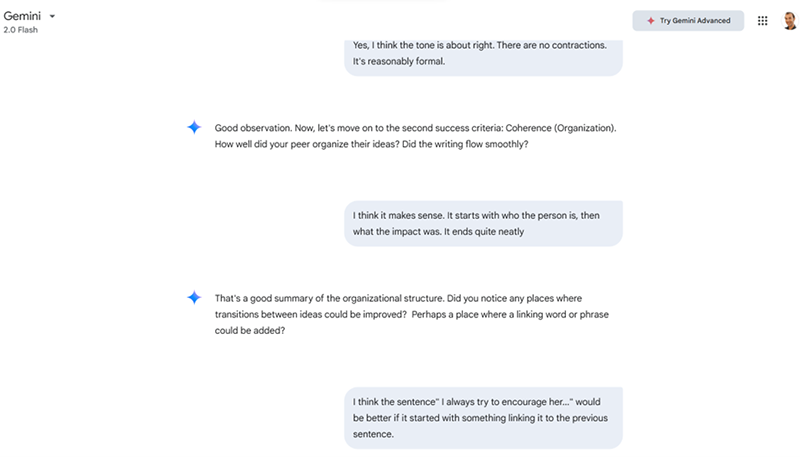
AI can also help students frame their feedback in a constructive and balanced way.
Prompt: I have written feedback for my peer’s work. Can you check if my comments are specific and constructive? If any are vague, ask me follow-up questions to help improve them. ### My feedback: {enter feedback here}
By using AI as a coaching tool rather than an answer generator, students stay in control of the peer review process while getting the support they need to give thoughtful, actionable feedback.
Limitations of AI in Assessment for Learning
We’ve seen that AI can help support teachers and students in using Assessment for Learning. With these recommendations come a few caveats.
- AI’s answers are quick, but not always right. If AI doesn’t fully understand the context, it might give confusing or inaccurate responses. Always check AI-generated learning intentions or success criteria before sharing them with students.
- AI can’t replace real conversations. If students can talk to classmates or get feedback from a teacher, that’s always better. AI is useful when human support isn’t available, but it shouldn’t be the first choice.
- AI is a tool, not a shortcut. Students can use AI to check their work and reflect, but they need to learn how to do this on their own. Try to reduce AI’s role over time so students don’t become too dependent on it.
- Not all students use AI well. Some will find help from AI useful. Others will want to use AI as a shortcut. Teaching students how to use AI responsibly is just as important as using the tool itself. For students who you suspect have outsourced their thinking to ChatGPT or Qwen, ask for evidence. Students can share a chat thread with you, showing how the sausage was made.
Conclusions
I can make Assessment for Learning more practical. It supports each step of the process:
- Before teaching, AI can generate diagnostic quizzes or turn objectives into student-friendly questions
- At the start of a lesson, AI can rephrase aims in simple language or the students’ L1
- Before a big task, AI can help students co-create success criteria and give examples of what success looks like
- After a task, AI can guide self-reflection, turn criteria into checklists, and coach students through peer feedback
Used this way, AI doesn’t replace teaching—it supports it. It saves you time, makes expectations clearer for students, and keeps AfL realistic even in busy classrooms.
If you’re trying this for the first time, don’t do everything at once. Pick one step and one prompt. Try it, see what works, and build from there.
Key Takeaways
- Assessment for Learning (AfL) helps students improve, not just measure progress
- Time is a barrier to AfL in many classrooms—AI can help reduce that burden
- AI can support AfL by generating quizzes, simplifying learning intentions, clarifying success criteria, and guiding students through reflection and peer review
- AI can coach students through self-assessment when teachers aren’t available
- AI can help students give more specific, constructive peer feedback
- Students need to learn how to use AI responsibly and independently
- AI should guide, not replace, classroom conversations or teacher feedback
- Start small—try one or two AI-supported activities and build from there



